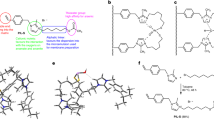Abstract
IN recent years the diffuse spectral reflectance properties of various solid systems have been investigated1,2, and several analytical applications have been developed3–5. Often it has been reported advantageous to mix the optically absorbing substance with an inactive powdered diluent such as sodium or potassium fluoride. When this is done the reflectance spectrum of the absorbing substance is sharpened and clarified in many cases. More pronounced effects have been obtained when a so-called active adsorbent powder such as chromatographic alumina or silica gel is substituted for the inactive diluent. In an attempt to study the nature of the changes brought about by active adsorbents in the solid state, pilot experiments have been carried out using Michler's ketone (4,4′-bisdimethylamino-benzophenone) mixed with active alumina. Michler's ketone has a well-defined absorption spectrum in transmittance in solution and reflectance from the solid, and is quantitatively removed from solution in a non-polar solvent by alumina. In a typical experiment 1 and 2 mgm. of the powdered ketone were mixed with 3 gm. of acidic and basic alumina (Woelm) and the solid mixtures allowed to stand for several days at room temperature in sealed containers. Visual changes slowly occurred in these systems until in appearance they were virtually identical with alumina on which the ketone had been adsorbed from a solution as in ordinary column chromatography. It is suggested that the two phenomena involve essentially the same adsorption process, differing only in rate.
This is a preview of subscription content, access via your institution
Access options
Subscribe to this journal
Receive 51 print issues and online access
$199.00 per year
only $3.90 per issue
Buy this article
- Purchase on Springer Link
- Instant access to full article PDF
Prices may be subject to local taxes which are calculated during checkout
Similar content being viewed by others
References
Griffiths, T. R., Lott, K. A. E., and Symons, M. C. R., Anal. Chem., 31, 1338 (1959).
Zeitlin, H., and Niimoto, A., Anal. Chem., 31, 1167 (1959).
Naughton, J. J., Frodyma, M. M., and Zeitlin, H., Science, 125, 121 (1957).
Naughton, J. J., Zeitlin, H., and Frodyma, M. M., J. Agric. Food Chem., 6, 933 (1958).
Shibata, K., J. Biochem. (Japan), 45, 599 (1958).
Author information
Authors and Affiliations
Rights and permissions
About this article
Cite this article
ANTHONY, P., ZEITLIN, H. Solid–Solid Interactions on Active Adsorbents. Nature 187, 936–937 (1960). https://doi.org/10.1038/187936a0
Issue Date:
DOI: https://doi.org/10.1038/187936a0
This article is cited by
-
Vertical distribution of fission elements in some soils of the USSR
Soviet Atomic Energy (1968)
Comments
By submitting a comment you agree to abide by our Terms and Community Guidelines. If you find something abusive or that does not comply with our terms or guidelines please flag it as inappropriate.



